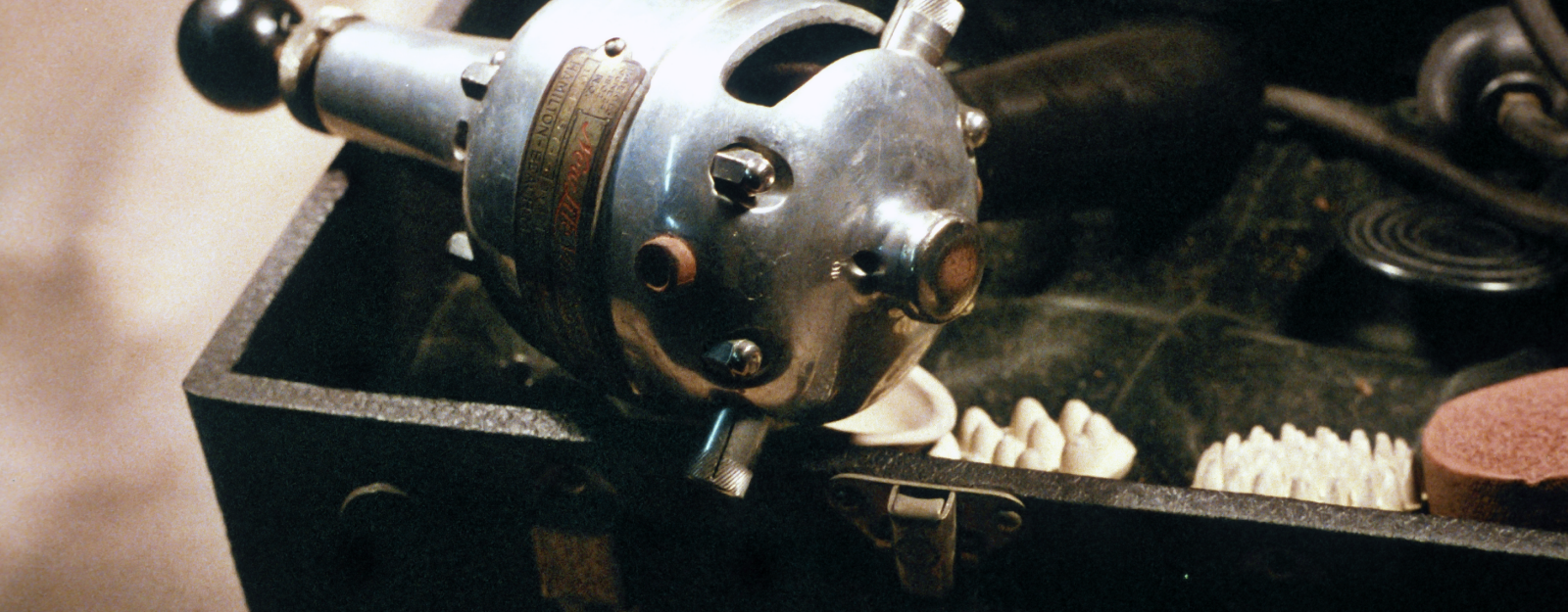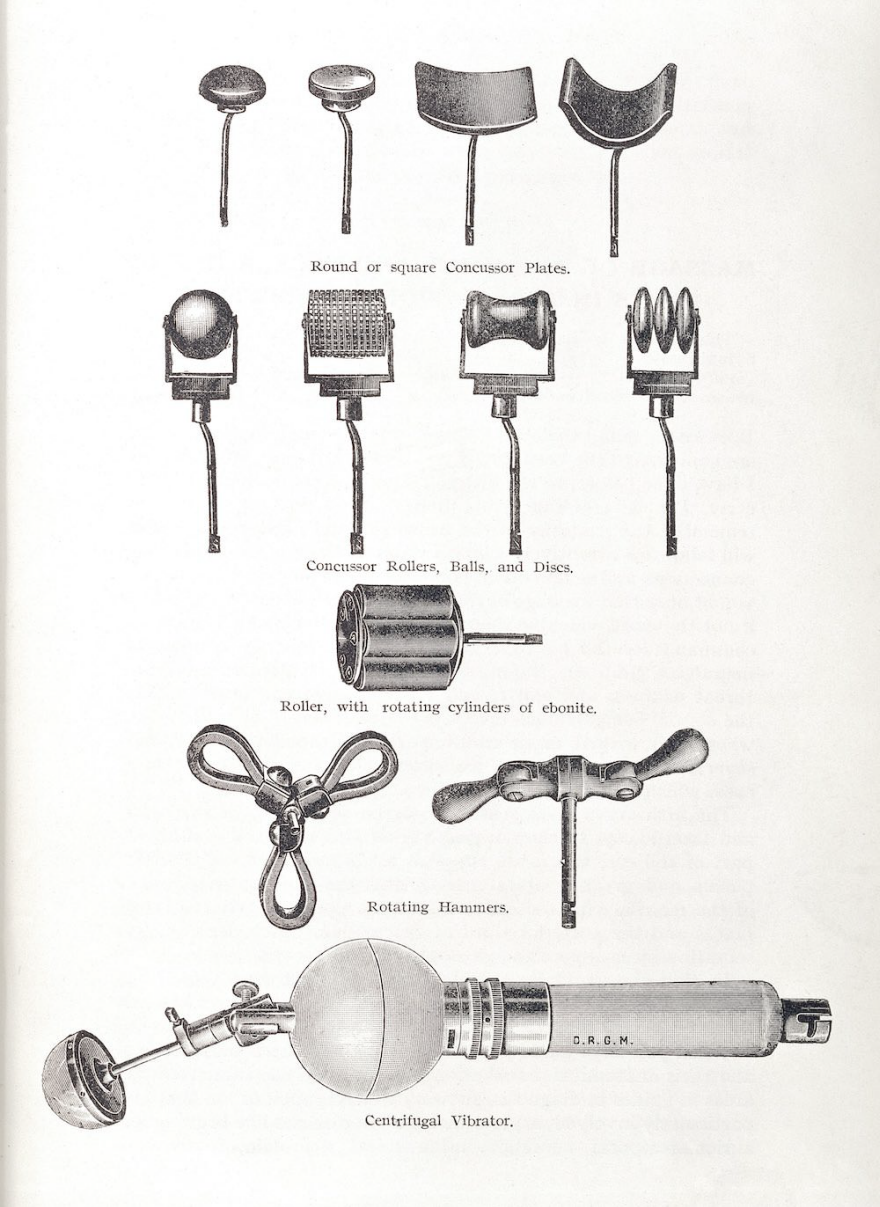
Sex Toys: A Short Version of a Rather Long History
They've been around a lot longer than you might think...
No need to be shy, human beings have been exploring sexuality since the dawn of time and as it turns out, sex toys have been around for just as long. The history of their design offers a strange, often humorous, look at our constant quest for innovation and connection. Here is only a small glimpse...
28,000 B.C.
 Enter a caption (optional)
Enter a caption (optional)The earliest known dildo was recently discovered at Hohle Fels Cave in Germany and found to date back to the Paleolithic era. While the jury is still out on whether or not its primary purpose was of a sexual nature (researchers think it was also used as a hammerstone), its high-gloss polish and the fact that other similarly carved stone/bone artifacts have been found among common personal care items seems to suggest it was the kind of object one would keep tucked away in their nightstand drawer (or cavernous nook, in this case)...
500 B.C.
 Enter a caption (optional)
Enter a caption (optional)It's no wonder that the Greeks and Romans—who worshipped Dionysus and Bacchus, gods of wine and fertility—would make room in their culture for sex toys. They even left us literary evidence of this: to persuade their partners into ending the war, the women of Aristophanes' "Lysistrata" withheld sex while enjoying dildos on the side. The Greeks were also keen on material innovations. In an effort to upgrade from hard (not to mention dangerous and uncomfortable) materials like stone, tar and wood, the Greeks developed olisbokollikes which were essentially dildos baked out of bread—or breadsticks, for a whole new take on "food porn." They also experimented with using olive oil as lube and covering dildos with a layer of leather or animal intestines to impart a more natural texture—a quality that sex toy manufacturers today continue to strive for. Meanwhile, the Romans are known for creating the double-ended dildo, which was used between partners, friends and even during certain ceremonies.
100 B.C.
 Fragment of the Turin Erotic papyrus depicting what seems to be a woman pleasuring herself with a cone-like object.
Fragment of the Turin Erotic papyrus depicting what seems to be a woman pleasuring herself with a cone-like object. This may be a complete rumor, but it is thought that Cleopatra was the mastermind behind the world's first vibrator. Apparently, the great seductress had her servants fill a hollowed-out gourd with bees and used the angry vibrations they emanated to pleasure herself.
1200
 Enter a caption (optional)
Enter a caption (optional)Chinese nobility believed that wearing cock rings would increase their chance of producing an heir. While many of these were beautiful objects in their own right carved out of jade and ivory, it was very common to find them made out of goat eyelids...with the eyelashes still attached for greater stimulation.
1818-1830
 Enter a caption (optional)
Enter a caption (optional)Woodblock prints from Japan's Edo Period show a catalog of sex toys for both men and women, organized according to the four seasons. The images were accompanied by pseudo-scientific explanations about why each sex toy should be used at a different time of the year, stemming from the belief that sex and health are inextricably intertwined. There was even a common saying about how often one should have sex for optimal health: "spring three [times a week], summer six, autumn one, winter none." Fittingly, the illustration for winter depicts a chastity device for men and a rather generous dildo for women.
1869
 The patient interface for George Taylor's steam-powered Manipulator (circa 1885)
The patient interface for George Taylor's steam-powered Manipulator (circa 1885)Ironically, the male doctors who devised and implemented the first vibrators were not at all concerned with women's sexual pleasure—they were attempting to rid themselves of the inconvenient hand cramps that came from treating "hysteria," a common "women's ailment" at the time that was treated by inducing a "hysterical paroxysm" (ie. orgasm) through manual stimulation. American physician George Taylor patented the first such machine in 1869, the steam-powered Manipulator—a padded table outfitted with a motor powering a vibrating ball in the center, where "treatments" were administered. (To make sure clientele walked out with a healthy glow, beauty parlors began using vibrators around the same time because "the sensations from their use are pleasing and the results instantaneous")
 The Chattanooga
The ChattanoogaAnother of these early devices was The Chattanooga, which was being sold around the end of the 19th century to doctors for just under $200—almost what it cost for an entire house! Here is a description of its complex workings:
"The Chattanooga…stood nearly 2m tall and required a couple of men to operate it. Being steam-powered, the engine of the machine was located in a small room and two men shoveled coal into the furnace and monitored the steam temperature, pressure, and thrust required to drive the Chattanooga. The engine room was separated from the doctor's room by a wall which had a hole in it. A mechanical arm extended from the engine through the wall and into the consulting room where the doctor controlled it and used the vibrating arm to administer the appropriate genital massage to the grateful patient."
 Another early example, this prototype for a steam-powered dildo was rejected by the US Patent Office in 1891. Though they were purportedly used to treat mental illness, it strikes us as absolutely bonkers that anyone could go near such a frightening device!
Another early example, this prototype for a steam-powered dildo was rejected by the US Patent Office in 1891. Though they were purportedly used to treat mental illness, it strikes us as absolutely bonkers that anyone could go near such a frightening device!1883
 Drawing of Granville's Electric Vibrator
Drawing of Granville's Electric VibratorThe vibrator market began to develop once consumers started to desire their personal machines. Dr. Mortimer Granville patented the first portable, battery-powered vibrator in 1883 and equipped it with an array of vibratodes (a fun word for attachments) to tickle every fancy.
 Drawing showing variation of vibratodes
Drawing showing variation of vibratodesThe vibrator was the fifth home appliance to be electrified (after the sewing machine, fan, teakettle and toaster) preceding the electric vacuum by about nine years. In the early 1900s, several personal models were on the market and advertisements touting the healing powers of vibration were common.
 Enter a caption (optional)
Enter a caption (optional) According to the Antique Vibrator Museum, the Vendee Vibratory Massager (1906) was operated by "loosening a nut the offset of the spinning weight can be adjusted thus controlling the magnitude of the vibration."
According to the Antique Vibrator Museum, the Vendee Vibratory Massager (1906) was operated by "loosening a nut the offset of the spinning weight can be adjusted thus controlling the magnitude of the vibration."  White Cross Electric Vibrator (1917)
White Cross Electric Vibrator (1917) The electric Gyro-Lator (1945) is the closes looking to modern day equivalents.
The electric Gyro-Lator (1945) is the closes looking to modern day equivalents. World War II
 Enter a caption (optional)
Enter a caption (optional)Classified as "Geheime Reichssache" (more secret than top secret) the Borghild Project was a German attempt to create the world's first sex doll during World War II in order to "counterbalance" the "unnecessary losses" their troops had suffered from STD's. As they outline below, their goals were lofty:
"The only purpose and goal of the dolls is to relieve our soldiers. They have to fight and not be on the prowl or mingle with foreign womenfolk. However, no real men will prefer a doll to a real woman, until our technicians meet the following quality standards:
1. The synthetic flesh has to feel the same like real flesh
2. The doll's body should be as agile and moveable as the real body
3. The doll's organ should feel absolutely realistic."
Bombs destroyed the Hygiene Museum of Dresden where their research was being conducted, so, for better or worse, we'll never know just what they had in the works.
1990-Present
 Enter a caption (optional)
Enter a caption (optional)We've certainly come a long way in terms of ergonomics! Toys like the Rabbit have entered the mainstream and become rather iconic in their own right. It's hard to think of a product category that spans across so many layers (ergonomic, emotional, psychological) and now—since they're no longer doctor-prescribed— we can begin to explore this multi-dimensionality through objects that celebrate our bodies and our senses.
2050
You decide! Send us your visionary designs for the 1-Hour Sex Toy Design Challenge!
 Enter a caption (optional)
Enter a caption (optional)This article is part of the Core77 Sex-tacular, an editorial series exploring the myriad ways that technology and design are shaping the future of intimacy and sex.
-
oFavorite This
-
QComment
K
{Welcome
Create a Core77 Account
Already have an account? Sign In
By creating a Core77 account you confirm that you accept the Terms of Use
K
Reset Password
Please enter your email and we will send an email to reset your password.

